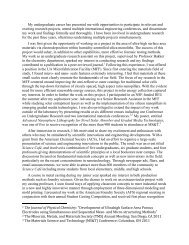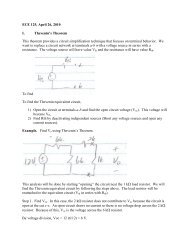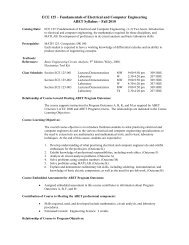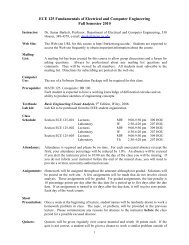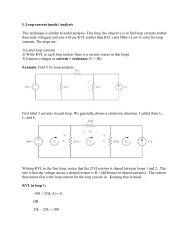Voltage/Current division
Voltage/Current division
Voltage/Current division
Create successful ePaper yourself
Turn your PDF publications into a flip-book with our unique Google optimized e-Paper software.
I. <strong>Voltage</strong> Division<br />
When you know the amount of voltage that will divide across resistors, it is easy to apply voltage<br />
<strong>division</strong> to determine the value of the drop across each resistor because it is proportional to the<br />
value of resistance. An example is given below:<br />
Determine V R1 and V R2<br />
+ V R1 -<br />
+<br />
V R2<br />
-<br />
KVL: -V S + V R1 + V R2 = 0<br />
V S = V R1 + V R2<br />
Apply Ohms Law: V S = I S R 1 + I S R 2<br />
Using this general expression, find the voltage across each resistor.<br />
V R1 = I S R 1 = (V S ) * R 1 = V S * R 1<br />
(R 1 +R 2 ) (R 1 +R 2 )<br />
V R1 = V R2 =<br />
Notice that the voltages are proportional to their resistance values (if R 2 >R 1 then V R2 >V R1 ).
The voltage across series resistors divides in direct proportion to the R value (Can be stated:<br />
<strong>Voltage</strong> drop across the resistor of interest is equal to the source voltage times the resistance of<br />
interest divided by the sum of resistances).<br />
More of the voltage drop goes to the larger resistance. If R 1 = R 2 , the <strong>division</strong> is equal.<br />
Same example with numerical values…<br />
II.<br />
<strong>Current</strong> Division<br />
When you know the current that is supplying parallel branches, you can apply current <strong>division</strong> to<br />
help find currents in the resistive branches. Unlike voltage <strong>division</strong>, the current flowing through<br />
a branch depends on the resistance of the opposite branch.<br />
Example:<br />
V = I S R eq = I S (R 1 *R 2 )<br />
R 1 +R 2<br />
What is I 1 I 1 = V/R 1<br />
= =<br />
So to determine the current in a branch containing R 1 , we will multiply the supply current by the<br />
resistance of the opposite branch and then divide by the sum of the two resistors.
It follows that:<br />
Same example with numerical values…<br />
Notice the current favors the path of least resistance.<br />
Example: Find V o<br />
First reduce the circuit:<br />
→<br />
30 kΩ and 60 kΩ are in parallel yielding 20 kΩ. V 1 = 6 V because the 2 resistors are equal
or by voltage <strong>division</strong>: V 1 = 12 (20k/40k) = 12 (1/2) = 6 V.<br />
Go back to the original circuit and label V 1<br />
Now apply voltage <strong>division</strong> again:<br />
V o = V 1 (20k/60k) = 6(1/3) = 2 V.<br />
You could also use current <strong>division</strong> to solve this problem:<br />
From the circuit below: I S = 12/40 kΩ = 3/10 mA<br />
So by current <strong>division</strong>:<br />
I o = 3/10 mA (30k/(30k + 60k)) = 3/10 (1/3)<br />
= 1/10 mA = 0.1 mA<br />
V o = 20k*I o = 20k (0.1 mA) = 2 V.<br />
Same answer as above.
More examples of current <strong>division</strong>.<br />
Find I S<br />
You are given the voltage across the 30 kΩ<br />
resistor.<br />
So, I 3 = 3/30k = 0.1 mA<br />
<strong>Current</strong> <strong>division</strong>:<br />
If I 3 = I S /3 then I S = 3I 3 = 3(0.1 mA) so I S = 0.3 mA<br />
Check your work.<br />
<strong>Voltage</strong> across 90 kΩ (V 90 ) is<br />
I 3 (90k) = 0.1 mA(90 kΩ) = 9 V.<br />
<strong>Voltage</strong> across 60 kΩ (V 60 ) is 9 + 3 = 12 V<br />
(KVL; -V 60 + 9 + 3 = 0)<br />
V 60 = I S *R eq<br />
Checks!
Another example illustrating both voltage and current <strong>division</strong><br />
Find I o<br />
Label nodes (a, b, c) and define currents in each resistor.<br />
Notice 4 kΩ and 12 kΩ are in parallel.<br />
That equivalent resistance is 3 kΩ. Redraw the circuit.<br />
You can redraw again noting that 3 kΩ is in series with 3 kΩ<br />
giving 6 kΩ.<br />
Because the branches are equal in resistance,<br />
I 1 = I 2 = 6 mA.<br />
Or by current <strong>division</strong>,<br />
I 1 = 12 mA (6k/12k) = 12 mA (1/2) = 6 mA.<br />
So now that you know both branch currents, you are closer to finding I o although you still need<br />
more information. Recognizing that all branches are in parallel means they have the same<br />
voltage across them. You could either combine resistors again (6 kΩ in parallel with 6 kΩ = 3<br />
kΩ) and use Ohm’s Law V = (12 mA) * (3 kΩ) = 36 V OR you could look at a single resistive<br />
branch and use Ohm’s Law: V = 6 mA (6 kΩ) = 36 V.
Now go back to an earlier circuit. If 36 V is the voltage across each branch, by voltage <strong>division</strong><br />
the voltage across each of the series 3 kΩ resistors is 18 V. (V ab = 36 (3k/6k) = 36 (1/2) = 18 V.)<br />
Go back to the original circuit.<br />
V ab is the voltage across the 4 kΩ resistor so …<br />
I o = 18/4k = 4.5 mA.<br />
To verify, write KCL at node b:<br />
I o + I 3 = I 1<br />
I o = I 1 - I 3 = 6 mA – I 3 and I 3 = 18/12k = 1.5 mA<br />
I o = (6-1.5) mA = 4.5 mA



